The Moon
470 - 482
In many ways the earth-moon system is more like a double planet than a planet and moon. The moon is very large (27%) the size of the earth which is a much larger proportion to the size of a parent planet for any other moon in the solar system. Further more its size is comparable to the largest moons of the Jovian planets.
The moon is interesting for a number of reasons. It certainly is an object of beauty and has been venerated by all peoples. It also represents a museum of the early history of the solar system.
Basic Facts
| average distance from earth 384,400 km maximum distance 405,500 km minimum distance 363,300 km |
| radius = 1738 km |
| period 27.32 days |
| mass is 7.35 X 1022 kg or 1.2% mass of Earth |
| local gravity 1.62 m/s2 |
| escape velocity 2.38 m/s |
| albedo 0.07 - 0.24; average is close to 0.07 |
| surface temperature from -170 C to +130 C |
| heavily cratered with some evidence of volcanism |
| no magnetic field (perhaps weak field in earlier epoch) |
| moon is tidally locked in orbit around earth center of mass is off-set from center of moon |
| lunar rocks are from 3 to 4.5 billion years old |
| Table 17.3 Some basic facts about the moon |
The Lunar Orbit
The moon travels around the earth with a nearly circular orbit of mean radius 384, 400 km and with a period of 27.321661 days.
The orbit is a synchronous . The moon's rotation rate is the same as its orbital rate - this means that we always see the same face of the moon pointing towards us. This phenomenon is called tidal locking and, as the name suggests is due to the tidal interaction between the earth and the moon. This effect is often "seen" or assumed to occur in the case of close binary stars. Figure 17.15 shows a Flash animation of the tidally-locked moon in its orbit around Earth. |
|
| Figure 17.15 |
Lunar "Geology" = Selenology
The moon has many similarities and some surprising difference with the earth. The composition of the moon is slightly differentiated and the age of the moon is essentially the same as that of the earth. The moon's composition however is decidedly different than is the earth's composition. The moon's composition favours the refractory elements (solid at high temperature) but is under abundant (wrt earth) in volatile elements. This suggests that the moon was formed at a higher temperature than was the earth.Also, the moon does show seismic activity - "moonquakes" which suggests that the lunar core may be partially molten. The lunar crust, on the other hand, is much thicker in relation to the lunar radius than is earth's. This is the result of the rapid cooling one would expect for a small body.
The structure of rocks on the lunar surface is also distinctly different than on earth. Most significant is the large number basalts and anorthosites (indicating lava flow) and breccias which are basically broken or pulverized rock "glued together". This would suggest that the lunar surface has been pummeled vigorously in its past.
The basalts also help define the darker regions on the lunar surface that we can see with the unaided eye. These are called lunar maria or seas and the low reflectivity or albedo is a property of basaltic materials. We now understand that the maria are huge lava flood plains. Another striking feature of the moon are the bright rays of material that emanate form major craters. This material (largely breccias) has much higher albedo and is essentially a more "glasslike" material formed at high temperature through heat generated in impact events. Figure 17.16 shows a possible composition profile for the moon. The moon has a much thicker crust (relative to its size) than does Earth. This is the result of the rapid cooling of a small body compared to a larger one. The interior of the moon is likely made up of rocky material made from minerals called olivines - these are minerals composed of silicon, magnesium ,iron and oxygen. |
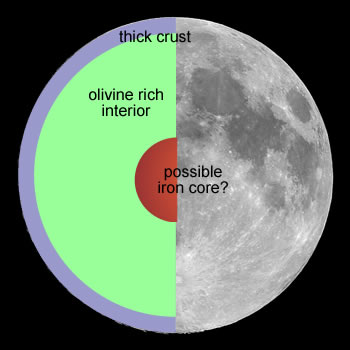 |
| Figure 17.16 Profile of lunar structure |
Lunar rocks collected by Apollo astronauts tell an interesting story. They have un-remarkable densities of about 3000 kg/m3 - which is typical for most surface rock on Earth. So where is the interesting story?
Example 17.6 Use the date from Table 17.3 to calculate the average density for the Moon. Why does the discovery that lunar surface rocks with average density of about 3000 kg/m3 imply that the internal structure of the moon must be quite different that that of the Earth?
Solution: Use the following:
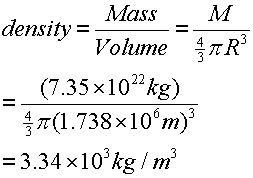 |
What is interesting about this result is that the surface rocks have essentially the same density - the moon is not as differentiated as the Earth. |
The Lunar Atmosphere
Basically - there is none! The moon is a small body gravitationally speaking. At the temperatures the bright side of the moon would be subject to gases would heat and reach velocities comparable to the velocity of gases in the earth's atmosphere. On the moon, however these gases would quickly escape ( diffuse ) into space. The lack of atmosphere, of course means that there is no weather and hence no weathering on the lunar surface.The Battered Moon and the Era of Bombardment
No atmosphere on the moon also means that lunar surface features will not erode as they do on Earth. As well, the moon, except for minor "moonquakes" is seismically dead. There are no plates moving and thereby destroying surface features. For this reason we can use the Moon's surface as a "museum" of past events in the history of the solar system. The story told by the Moon's surface is fascinating. Figures 17.17a,b show two regions of the lunar surface. Figure 17.a7a is shows the crater Capuanus ("claw-like" crater in the lower left) on the edge of Mare Nubium. The craters have been produced by violent impact events. The crater floors and surrounding lunar maria are the result of massive lava-flooding that likely occurred when the impact events fractured the lunar crust. This occurred roughly from 3.8 to 3.2 billion years ago. The interior of the Moon was still hot (molten) at this time but has since then cooled so that and Figure 17.7b shows the crater Clavius. Clavius is found in the Lunar Highlands which is a region of the moon in which the crust was thick enough to withstand impacts and was not prone to lava flooding events. Notice that inside this and most large craters are numerous smaller craters. These must have occurred after the last major episode of flooding and gives us a way to measure the rate at which impacts have occurred in the past. By counting the number and size of craters on the lunar surface a rough estimate of the rate of impact events can be constructed.
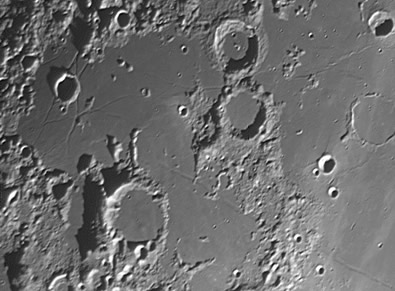 |
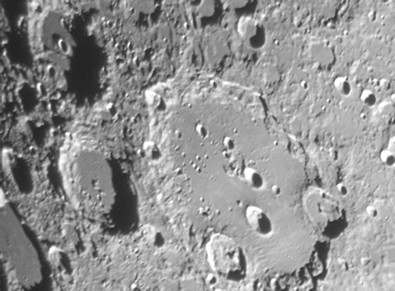 |
| Figure 17.17a Crater Capuanus in lower left corner. (Image courtesy The King's University College Observatory) - click to enlarge | Figure 17.17b Crater Claviuss in lower centre. (Image courtesy The King's University College Observatory) - click to enlarge |
 |
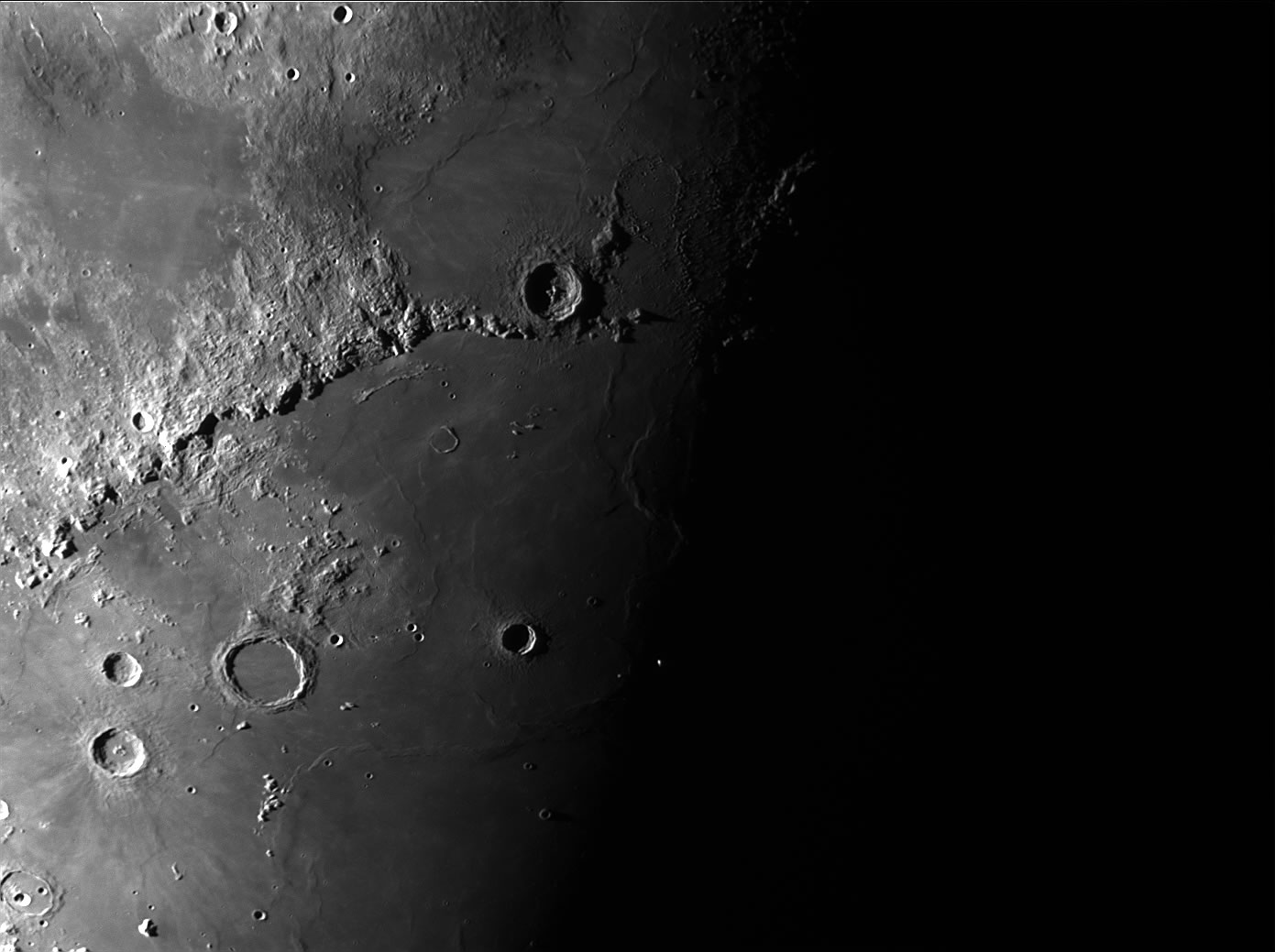 |
| Figure 17.17c Expanded region around Gassendi, Copernicus ,and Kepler craters. (Image courtesy The King's University College Observatory) - click to enlarge | Figure 17.17d The Appenine Mountains and the crater Eratosthenes. (Image courtesy The King's University College Observatory) - click to enlarge |
As another way to view the bombardment history of the moon over the past 4.5 billion years use the applet "mooonGlobe" to examine the moon. Notice the marked difference between the appearance of the side of the moon that we see compared to the "dark-side" of the moon or the side that always faces away from us.
| Figure 17.18 |
Example 17.7 Carefully inspect the following lunar image and pay special attention to the features marked "A" and "B". Comment on what is significant about these features - How, for example did they form?
| Solution: Feature A looks very much like a river channel - not a river of water but of lava! This is an example of a lunar rille and is likely either a channel cut by lowing lava or a collapsed channel through which lava flowed when Mare Nubium was being formed. B looks very much like an old crater that is partially submerged by the lava flow that formed Mare Nubium. | 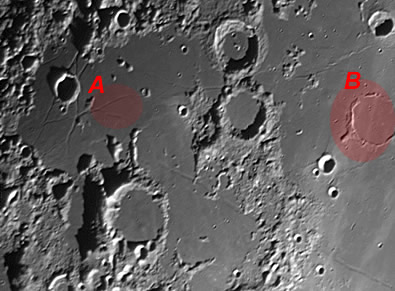 |
Origin of the Moon
Each of the following scenarios have been proposed as possible explanations for the Moon's origin. Today, the evidence seems to support the large-impact hypothesis.
- fission hypothesis : spinning semi-molten earth split into two bodies. Problem: why was the earth spinning so fast (10x) and where did the angular momentum go?
- co-accretion : moon and earth formed together. Problem: why the very different compositions.
- capture hypothesis : moon formed closer to the sun and was capture by the earth. Problem: requires a very unlikely set of interaction between the inner planets (3 - body encounter).
- large-impact hypothesis : A larger body hit the earth-moon planetesimal. The moon formed from some of the debris. The ejecta would be primarily crust . So far this looks like the winner.
The following Flash animation illustrates each of these hypotheses.
Practice
|
 |
 |

To understand the Moon within the context of the SNT
Chp 21-1
![]()
 Albedo is a measure of the reflectivity of a material and is a fraction between 0 and 1. An albedo of 0.25 would mean that a body reflects one-quarter (0.25) of the light energy falling on it.
Albedo is a measure of the reflectivity of a material and is a fraction between 0 and 1. An albedo of 0.25 would mean that a body reflects one-quarter (0.25) of the light energy falling on it.

micrometeorite impacts and the solar wind are the only main contributors to "erosion" on the lunar surface

The "dark-side" of the moon is no more dark than is the side we see. Just because we cannot see the other side of the moon does not mean it is not illuminated. When the moon is new, for example, the "dark-side" will be fully illuminated.